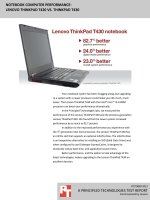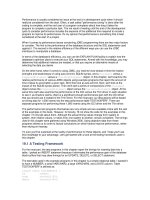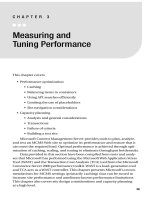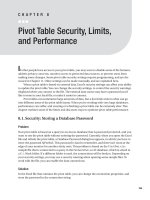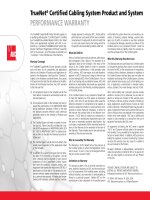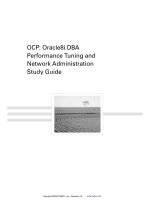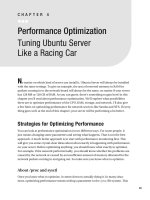Performance
Bạn đang xem bản rút gọn của tài liệu. Xem và tải ngay bản đầy đủ của tài liệu tại đây (60.55 KB, 8 trang )
Performance is usually considered an issue at the end of a development cycle when it should
really be considered from the start. Often, a task called "performance tuning" is done after the
coding is complete, and the end user of a program complains about how long it takes the
program to complete a particular task. The net result of waiting until the end of the development
cycle to consider performance includes the expense of the additional time required to recode a
program to improve its performance. It's my opinion that performance is something that is best
considered at the start of a project.
When it comes to performance issues concerning JDBC programming there are two major factors
to consider. The first is the performance of the database structure and the SQL statements used
against it. The second is the relative efficiency of the different ways you can use the JDBC
interfaces to manipulate a database.
In terms of the database's efficiency, you can use the EXPLAIN PLAN facility to explain how the
database's optimizer plans to execute your SQL statements. Armed with this knowledge, you may
determine that additional indexes are needed, or that you require an alternative means of
selecting the data you desire.
On the other hand, when it comes to using JDBC, you need to know ahead of time the relative
strengths and weaknesses of using auto-commit, SQL92 syntax, and a Statement versus a
PreparedStatement versus a CallableStatement object. In this chapter, we'll examine the
relative performance of various JDBC objects using example programs that report the amount of
time it takes to accomplish a given task. We'll first look at auto-commit. Next, we'll look at the
impact of the SQL92 syntax parser. Then we'll start a series of comparisons of the Statement
object versus the PreparedStatement object versus the CallableStatement object. At the
same time we'll also examine the performance of the OCI versus the Thin driver in each situation
to see if, as Oracle's claims, there is a significant enough performance gain with the OCI driver
that you should use it instead of the Thin driver. For the most part, our discussions will be based
on timing data for 1,000 inserts into the test performance table TESTXXXPERF. There are
separate programs for performing these 1,000 inserts using the OCI driver and the Thin driver.
The performance test programs themselves are very simple and are available online with the rest
of the examples in this book. However, for brevity, I'll not show the code for the examples in this
chapter. I'll only talk about them. Although the actual timing values change from system to
system, their relative values, or ratios from one system to another, remain consistent. The timings
used in this chapter were gathered using Windows 2000. Using objective data from these
programs allows us to come to factual conclusions on which factors improve performance, rather
than relying on hearsay.
I'm sure you'll be surprised at the reality of performance for these objects, and I hope you'll use
this knowledge to your advantage. Let's get started with a look at the testing framework used in
this chapter.
19.1 A Testing Framework
For the most part, the test programs in this chapter report the timings for inserting data into a
table. I picked an INSERT statement because it eliminates the performance gain of the database
block buffers that may skew timings for an UPDATE, DELETE, or SELECT statement.
The test table used in the example programs in this chapter is a simple relational table. I wanted it
to have a NUMBER, a small VARCHAR2, a large VARCHAR2, and a DATE column. Table
TESTXXXPERF is defined as:
create table TestXXXPerf (
id number,
code varchar2(30),
descr varchar2(80),
insert_user varchar2(30),
insert_date date )
tablespace users pctfree 20
storage( initial 1 M next 1 M pctincrease 0 );
alter table TestXXXPerf
add constraint TestXXXPerf_Pk
primary key ( id )
using index
tablespace users pctfree 20
storage( initial 1 M next 1 M pctincrease 0 );
The initial extent size used for the table makes it unlikely that the database will need to take the
time to allocate another extent during the execution of one of the test programs. Therefore, extent
allocation will not impact the timings. Given this background, you should have a context to
understand what is done in each section by each test program.
19.2 Auto-Commit
By default, JDBC's auto-commit feature is on, which means that each SQL statement is
committed as it is executed. If more than one SQL statement is executed by your program, then a
small performance increase can be achieved by turning off auto-commit.
Let's take a look at some numbers. Table 19-1 shows the average time, in milliseconds, needed
to insert 1,000 rows into the TESTXXXPERF table using a Statement object. The timings
represent the average from three runs of the program. Both drivers experience approximately a
one-second loss as overhead for committing between each SQL statement. When you divide that
one second by 1,000 inserts, you can see that turning off auto-commit saves approximately 0.001
seconds (1 millisecond) per SQL statement. While that's not interesting enough to write home
about, it does demonstrate how auto-commit can impact performance.
Table 19-1. Auto-commit timings (in milliseconds)
Auto-commit OCI Thin
On 3,712 3,675
Off 2,613 2,594
Clearly, it's more important to turn off auto-commit for managing multistep transactions than for
gaining performance. But on a heavily loaded system where many users are committing
transactions, the amount of time it takes to perform commits can become quite significant. So my
recommendation is to turn off auto-commit and manage your transactions manually. The rest of
the tests in this chapter are performed with auto-commit turned off.
19.3 SQL92 Token Parsing
Like auto-commit, SQL92 escape syntax token parsing is on by default. In case you don't recall,
SQL92 token parsing allows you to embed SQL92 escape syntax in your SQL statements (see
Section 9.3.3 in Chapter 9). These standards-based snippets of syntax are parsed by a JDBC
driver transforming the SQL statement into its native syntax for the target database. SQL92
escape syntax allows you to make your code more portable -- but does this portability come with
a cost in terms of performance?
Table 19-2 shows the number of milliseconds needed to insert 1,000 rows into the
TESTXXXPERF table. Timings are shown with the SQL92 escape syntax parser on and off for
both the OCI and Thin drivers. As before, these timings represent the result of three program runs
averaged together.
Table 19-2. SQL92 token parser timings (in milliseconds)
SQL92 parser OCI Thin
On 2,567 2,514
Off 2,744 2,550
Notice from Table 19-2 that with the OCI driver we lose 177 milliseconds when escape syntax
parsing is turned off, and we lose only 37 milliseconds when the parser is turned off with the Thin
driver. These results are the opposite of what you might intuitively expect. It appears that both
drivers have been optimized for SQL92 parsing, so you should leave it on for best performance.
Now that you know you never have to worry about turning the SQL92 parser off, let's move on to
something that has some potential for providing a substantial performance improvement.
19.4 Statement Versus PreparedStatement
There's a popular belief that using a PreparedStatement object is faster than using a
Statement object. After all, a prepared statement has to verify its metadata against the
database only once, while a statement has to do it every time. So how could it be any other way?
Well, the truth of the matter is that it takes about 65 iterations of a prepared statement before its
total time for execution catches up with a statement. This has performance implications for your
application, and exploring these issues is what this section is all about.
When it comes to which SQL statement object performs better under typical use, a Statement
or a PreparedStatement, the truth is that the Statement object yields the best performance.
When you consider how SQL statements are typically used in an application -- 1 or 2 here,
maybe 10-20 (rarely more) per transaction -- you realize that a Statement object will perform
them in less time than a PreparedStatement object. In the next two sections, we'll look at this
performance issue with respect to both the OCI driver and the Thin driver.
19.4.1 The OCI Driver
Table 19-3 shows the timings in milliseconds for 1 insert and 1,000 inserts in the
TESTXXXPERF table. The inserts are done first using a Statement object and then a
PreparedStatement object. If you look at the results for 1,000 inserts, you may think that a
prepared statement performs better. After all, at 1,000 inserts, the PreparedStatement object
is almost twice as fast as the Statement object, but if you examine Figure 19-1, you'll see a
different story.
Table 19-3. OCI driver timings (in milliseconds)
Inserts Statement PreparedStatement
1 10 113
1,000 2,804 1,412
Figure 19-1 is a graph of the timings needed to insert varying numbers of rows using both a
Statement object and a PreparedStatement object. The number of inserts begins at 1 and
climbs in intervals of 10 up to a maximum of 150 inserts. For this graph and for those that follow,
the lines themselves are polynomial trend lines with a factor of 2. I chose polynomial lines instead
of straight trend lines so you can better see a change in the performance as the number of inserts
increases. I chose a factor of 2 so the lines have only one curve in them. The important thing to
notice about the graph is that it's not until about 65 inserts that the PreparedStatement object
outperforms the Statement object. 65 inserts! Clearly, the Statement object is more efficient
under typical use when using the OCI driver.
Figure 19-1. OCI driver timings
19.4.2 The Thin Driver
If you examine Table 19-4 (which shows the same timings as for Table 19-3, but for the Thin
driver) and Figure 19-2 (which shows the data incrementally), you'll see that the Thin driver
follows the same behavior as the OCI driver. However, since the Statement object starts out
performing better than the PreparedStatement object, it takes about 125 inserts for the
PreparedStatement to outperform Statement.
Table 19-4. Thin driver timings (in milliseconds)
Inserts Statement PreparedStatement
1 10 113
1,000 2,583 1,739
Figure 19-2. Thin driver timings
When you consider typical SQL statement usage, even with the Thin driver, you'll get better
performance if you execute your SQL statements using a Statement object instead of a
PreparedStatement object. Given that, you may ask: why use a PreparedStatement at all?
It turns out that there are some reasons why you might use a PreparedStatement object to
execute SQL statements. First, there are several types of operations that you simply can't
perform without a PreparedStatement object. For example, you must use a
PreparedStatement object if you want to use large objects like BLOBs or CLOBs or if you wish
to use object SQL. Essentially, you trade some loss of performance for the added functionality of
using these object technologies. A second reason to use a PreparedStatement is its support
for batching.
19.5 Batching
As you saw in the previous section, PreparedStatement objects eventually become more
efficient than their Statement counterparts after 65-125 executions of the same statement. If
you're going to execute a given SQL statement a large number of times, it makes sense from a
performance standpoint to use a PreparedStatement object. But if you're really going to do
that many executions of a statement, or perhaps more than 50, you should consider batching.
Batching is more efficient because it sends multiple SQL statements to the server at one time.
Although JDBC defines batching capability for Statement objects, Oracle supports batching only
when Prepared-Statement objects are used. This makes some sense. A SQL statement in a
PreparedStatement object is parsed once and can be reused many times. This naturally lends
itself to batching.
19.5.1 The OCI Driver
Table 19-5 lists Statement and batched PreparedStatement timings, in milliseconds, for 1
insert and for 1,000 inserts. At the low end, one insert, you take a small performance hit for
supporting batching. At the high end, 1,000 inserts, you've gained 75% throughput.
Table 19-5. OCI driver timings (in milliseconds)
Inserts Statement Batched
1 10 117
1,000 2,804 691
If you examine Figure 19-3, a trend line analysis of the Statement object versus the batched
PreparedStatement object, you'll see that this time, the batched Prepared-Statement


